
 Data Structure
Data Structure Networking
Networking RDBMS
RDBMS Operating System
Operating System Java
Java MS Excel
MS Excel iOS
iOS HTML
HTML CSS
CSS Android
Android Python
Python C Programming
C Programming C++
C++ C#
C# MongoDB
MongoDB MySQL
MySQL Javascript
Javascript PHP
PHP
- Selected Reading
- UPSC IAS Exams Notes
- Developer's Best Practices
- Questions and Answers
- Effective Resume Writing
- HR Interview Questions
- Computer Glossary
- Who is Who
How to Prevent Special Characters Entering in Excel?
It is crucial to keep your Excel data clean and consistent at all times. The introduction of special characters that cause problems with data processing, arithmetic, or formatting is a frequent source of difficulty. Errors, misreading of data, and formatting difficulties may occur if special characters like symbols, emojis, or non-printable characters are used. Luckily, Excel has a number of features to safeguard your data by preventing the introduction of non-alphanumeric characters. This tutorial will show you how to block Excel from accepting data with special characters, helping you keep your data clean and simplifying your data administration.
Below are the steps to prevent special characters from entering in Excel.
Data Validation
Step 1 To begin applying validation, choose the cells or range to which you wish to apply it.
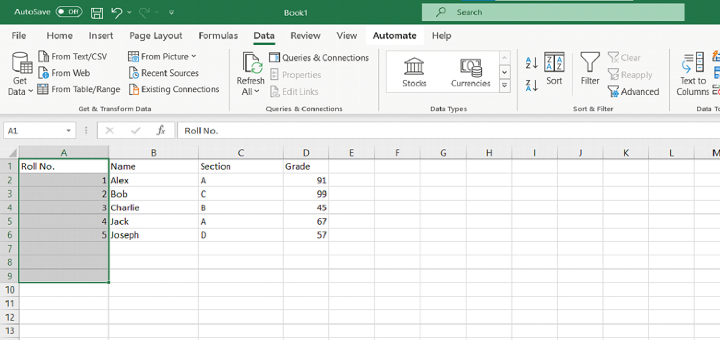
Step 2 go to the Data tab on Excel's ribbon and click the "Data Validation" button.
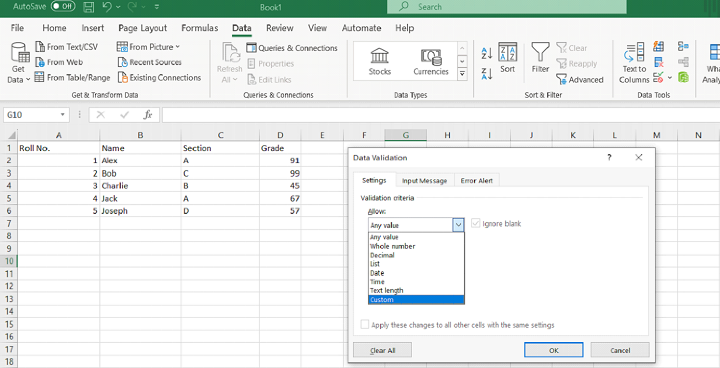
Step 3 In the Data -Validation dialogue box, choose the "Settings" tab.
Step 4 For the "Allow" option, choose "Custom."
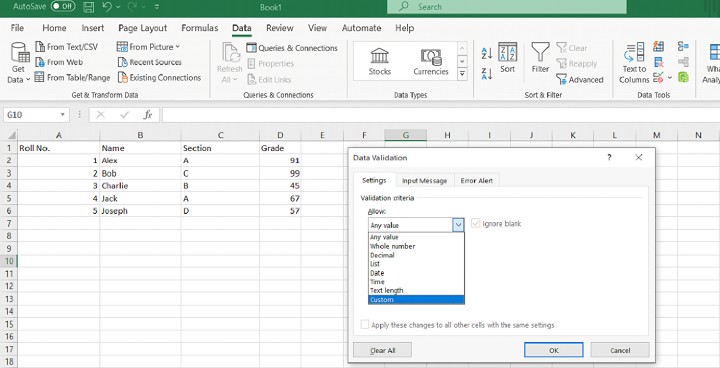
Step 5 Enter formula in the (Formula)field to limit input to numbers and letters. The following is a sample formula you may use
Iserror(Find("~",A1))
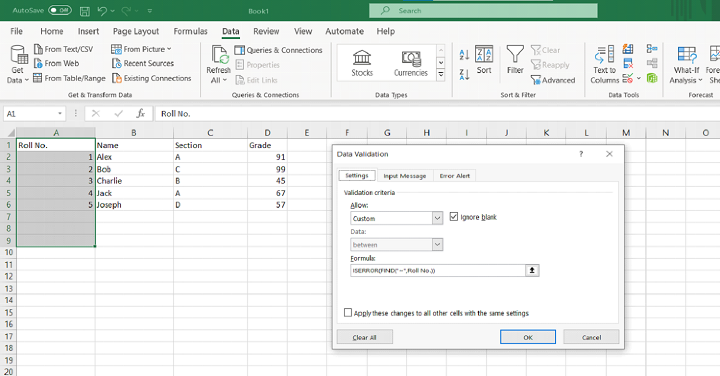
This formula checks, if the cell contains the tilde (~) character. If the character is found, it returns an error (TRUE) and prevents the input.
Step 6 Click on the "Error Alert" tab in the Data Validation dialog box.
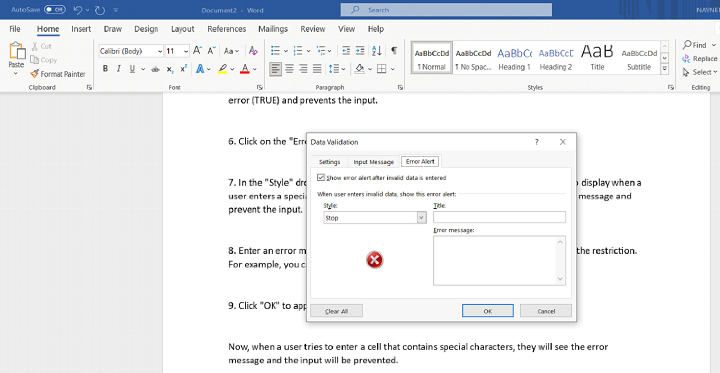
Step 7 To customize the error message that appears when a user inputs a non-standard character, click the "Style" drop-down box. Selecting "Stop" will display an alert and halt further input, for instance.
Step 8 In the "Error message" text box, type a message explaining the limitation to the user. You may put in anything like "Special characters are not permitted," for instance.
Step 9 Click "OK" to apply the data validation rule.
Users will now get the error notice and be unable to enter data into a cell containing special characters.
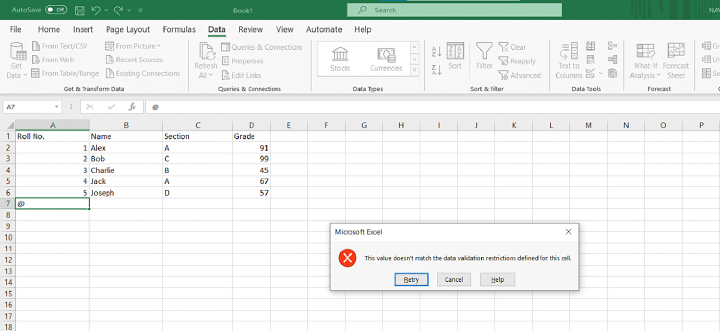
Custom Formulas
Select the cell(s) or range where you want to prevent special characters.
Go to the "Data" tab and click on the "Data Validation" button.
In the "Data Validation" dialog box, select the "Custom" option from the "Allow" drop-down menu.
In the "Formula" field, enter a formula that checks for the presence of special characters. For example, you can use the formula "=ISERROR(FIND("",A1))" to prevent the entry of the tilde () character in cell A1.
Customize the error message in the "Error Alert" tab.
Click "OK" to apply the custom formula validation rule. Users will now be restricted from entering special characters based on the specified formula.
Using Excel Functions
Instead of always blocking special characters from being entered, you may find it more convenient to automatically delete or replace them. Excel's many useful features make this a breeze.
To change the appearance of a few key special characters into regular text, use the SUBSTITUTE function. Example: "=SUBSTITUTE(A1,"","")" may be used to replace all instances of the tilde () character in cell A1.
You may delete or replace several special characters by using SUBSTITUTE with other actions like CLEAN, TRIM, or REGEXREPLACE.
When you're ready to use the rule for validating custom formulas, click the "OK" button. The supplied formula will now prevent users from inserting special characters.
Excel Add-Ins
Numerous Excel add-ins provide sophisticated tools for blocking and handling special characters.
Look at plug-ins like ASAP Utilities, Kutools for Excel, or Ablebits to have access to a variety of tools designed to deal with special characters and enhance data integrity.
Conclusion
It is essential that special characters not be typed into Excel in order to preserve the integrity of the data, as well as to ensure accurate analysis, calculations, and formatting. You will be able to prevent the unintentional entry of special characters into your data, which might lead to its corruption, if you follow the directions in this handbook exactly as they are written.
You have the option of either employing data validation in conjunction with text length requirements or developing your own algorithms in order to restrict the entry of special characters into Excel. In addition, by using the SUBSTITUTE, CLEAN, TRIM, or REGEXREPLACE capabilities that are available in Excel, you will have the ability to effortlessly delete or substitute special characters.
It is advised that you research Excel add-ins that give unique solutions for processing special characters in order to further develop your data management abilities. These add-ins may be found on the Excel website. If you use these strategies, your Excel data will remain organized and consistent, which will make it possible to conduct more accurate analyses and ensure that procedures run more smoothly.

